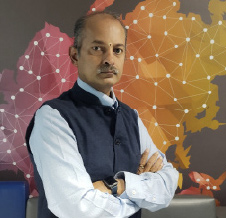
ATUL KUMAR
DIRECTOR - DSCI
In a compelling talk on the evolution and future of cybersecurity, he offered a broad perspective on how emerging technologies are reshaping the cyber landscape. He shared that while discussing emerging technologies, we often focus on IoT, AI, and cloud, but I believe we also need to look at adjacent fields like material sciences, which are quietly but significantly shaping cyber innovation. For instance, Microsoft’s Majorana quantum chip was celebrated as a quantum breakthrough, but behind it was a major material science innovation—supported in its final phase by generative AI models, which expedited the 20-year research.
This illustrates how interdisciplinary advancements are pushing cybersecurity forward, and also widening the scope of threats. With the digital economy expanding, we’re facing increased vulnerabilities, attack surfaces, and sophisticated threat actors exploiting gaps in systems and processes—financial or otherwise. The disparity in cyber awareness across individuals, SMBs, and large enterprises adds to this complexity. Adversaries are now using the same tech—AI, crypto, cross-platform tools, even the dark web—to launch polymorphic malware and adaptive threats like those from Salt Typhoon or Lazarus groups. These attacks evolve during deployment, making them harder to detect. The crimes born from this tech misuse span personal, societal, and even geopolitical dimensions, touching on terrorism, separatism, and extremism. A major challenge lies in the gap between fast-moving tech and slow-moving policy. Legal frameworks, infrastructure readiness, and cyber skills are often outdated. With AI, quantum computing, media, the risks to electoral systems, diplomacy, and biosecurity are real and growing.
Even export controls are no longer foolproof, as open-source models like China’s DeepSeek enter global supply chains unnoticed. This raises the importance of a resilient and innovative cybersecurity ecosystem. Fortunately, India is emerging as a global hub, with over 450 cybersecurity product firms. Our architecture, policies, and awareness strategies must evolve in sync with the pace of both innovation and adoption.
In conclusion, while the landscape is daunting, the answer lies in responsible innovation, cross-disciplinary thinking, and collective vigilance. The more we nurture this ecosystem, the stronger and safer our digital future will be.
See What’s Next in Tech With the Fast Forward Newsletter
Tweets From @varindiamag
Nothing to see here - yet
When they Tweet, their Tweets will show up here.




























